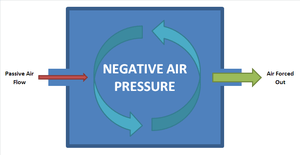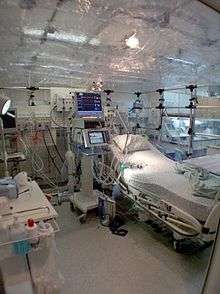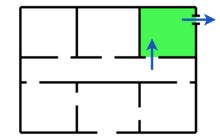Negative room pressure
Negative room pressure is an isolation technique used in hospitals and medical centers to prevent cross-contaminations from room to room.[1][2] It includes a ventilation that generates negative pressure to allow air to flow into the isolation room but not escape from the room, as air will naturally flow from areas with higher pressure to areas with lower pressure, thereby preventing contaminated air from escaping the room. This technique is used to isolate patients with airborne contagious diseases such as tuberculosis, measles, or chickenpox.[3][4]


Mechanism

Negative pressure is generated and maintained by a ventilation system that removes more exhaust air from the room than air is allowed into the room. Air is allowed into the room through a gap under the door (typically about one half-inch high). Except for this gap, the room should be as airtight as possible, allowing no air in through cracks and gaps, such as those around windows, light fixtures and electrical outlets. Leakage from these sources can compromise or eliminate room negative pressure.[1]
Smoke test
A smoke test can help determine whether a room is under negative pressure.[5] A tube containing smoke is held near the bottom of the negative pressure room door, about 2 inches in front of the door. The smoke tube is held parallel to the door, and a small amount of smoke is then generated by gently squeezing the bulb. Care is taken to release the smoke from the tube slowly to ensure the velocity of the smoke from the tube does not overpower the air velocity. If the room is at negative pressure, the smoke will travel under the door and into the room. If the room is not a negative pressure, the smoke will be blown outward or will stay stationary.
See also
- Positive room pressure
References
- Negative Room Pressure to Prevent Cross-Contamination, Clean Air Solutions, Camil Farr, Retrieved 2010-03-10.
- Isolation Rooms & Pressurization Control, Penn State Department of Architectural Engineering, © 2008 The Pennsylvania State University. Retrieved 2010-03-10.
- Negative Pressure Isolation Rooms & Tuberculosis (TB) Isolation Rooms, AirMont Inc. Retrieved 2010-03-10.
- P. N. Hoffman, a, M. J. Weinbrenb and S. A. Stuartc. A practical lesson in negative-pressure isolation ventilation. Journal of Hospital Infection. Volume 57, Issue 4, August 2004, Pages 345-346.
- Title: Negative Pressure Isolation Rooms, Minnesota Department of Corrections, Issue date 2007-07-03. Retrieved 2010-03-12.